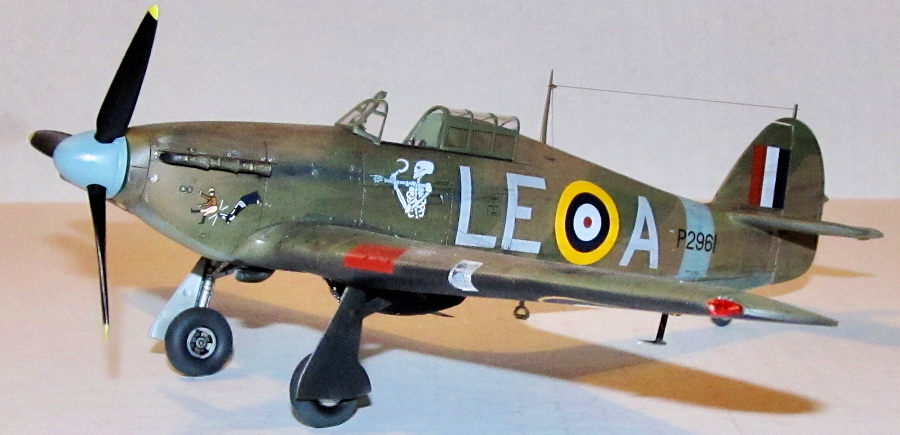
Airfix 1/48 Hurricane I
| KIT #: | A05127 |
| PRICE: | $24.99 SRP |
| DECALS: | Two options |
| REVIEWER: | Dan Lee |
| NOTES: | Ultracast Resin Seat and Aeromaster Decals “Battle of Britain” |

| HISTORY |
William McKnight was born in November of 1918 in Edmonton. He was known to be a colorful character as a teen and in 1939 was admitted to the University of Alberta School of Medicine. However, Medical School really wasn't for him though. He was on the verge of being kicked out when a RAF Recruiting Mission arrived in Calgary looking for pilots. Willie passed the exams and soon found himself on his way to England.
McKnight apparently was a disciplinary problem during training as he was confined to barracks for two weeks along with another classmate as “perpetrators of a riot.” However, the RAF really needed trained pilots and graduated McKnight and the rest of his class after Germany invaded Poland.
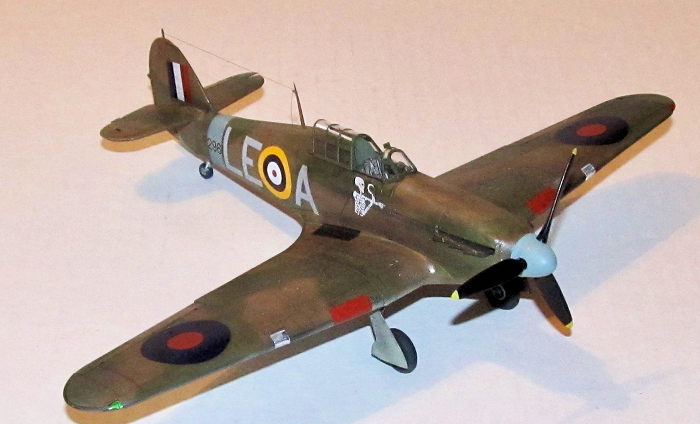 In May 1940, Willie McKnight was assigned to Number
242 Squadron aka the “Canadian” Squadron which was made up of a majority of
Canadian personnel. No. 242 Squadron was sent to France on May 14 as part of the
RAF Expeditionary Force. On May 19th, McKnight recorded 242's first kill after
his flight was bounced by Bf-109s. He spotted the attacking 109s, went into a
climbing turn, found a 109 in his sights and shot it down. In the final days of
the Battle of France, the situation became, well, fluid. In the desperate fights
over France, McKnight shot down a total of 10 German planes including six over
Dunkirk during the evacuation. However, 242 and McKnight suffered as 242 lost 11
pilots while McKnight suffered combat exhaustion and was sent to hospital to
recuperate.
In May 1940, Willie McKnight was assigned to Number
242 Squadron aka the “Canadian” Squadron which was made up of a majority of
Canadian personnel. No. 242 Squadron was sent to France on May 14 as part of the
RAF Expeditionary Force. On May 19th, McKnight recorded 242's first kill after
his flight was bounced by Bf-109s. He spotted the attacking 109s, went into a
climbing turn, found a 109 in his sights and shot it down. In the final days of
the Battle of France, the situation became, well, fluid. In the desperate fights
over France, McKnight shot down a total of 10 German planes including six over
Dunkirk during the evacuation. However, 242 and McKnight suffered as 242 lost 11
pilots while McKnight suffered combat exhaustion and was sent to hospital to
recuperate.
McKnight was among those who were weary of their double amputee new Squadron CO, Douglas Bader. Bader being the force he was “whipped” these Canadians into shape even winning over McKnight who would become the boss' favorite and his new wingman. Willie's new Hurricane was painted with a boot kicking Hitler in the butt as well as a death's head and skeleton with a sickle (a reminder of his less than successful medical school days.) He scored seven official kills flying with Bader as 242 became the focal point for Bader's Big Wing doctrine (which proved to be quite the dud.)
After the Battle of Britain and the boneheaded
dismissal of Parks and Dowding, the Sholto Douglas mafia (including Bader) took
over Fighter Command. One of their less than successful ideas was the “Non-Stop
Offe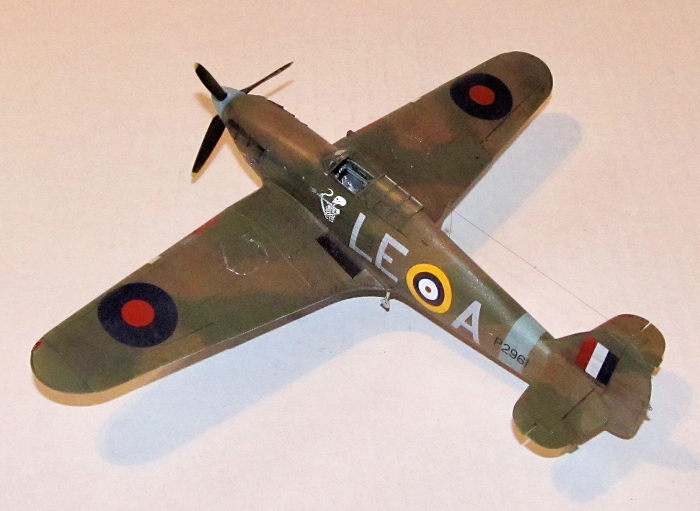 nsive” which would prove to be a waste of experienced pilots. In 1941, 242
Squadron was part of the initial “Non-Stop Offensive” as they attacked targets
in France.
nsive” which would prove to be a waste of experienced pilots. In 1941, 242
Squadron was part of the initial “Non-Stop Offensive” as they attacked targets
in France.
On January 12, 1941, McKnight and another pilot attacked an E-Boat in the English Channel during a Rhubarb (fighter sweep) as the duo was attacked by a Bf-109. McKnight's wingman made it back but McKnight did not. Bader was distraught at losing his friend and vowed revenge but nothing came of it. McKnight died as Canada's 5th highest ranking ace at the end of the war with 17 confirmed kills.
242 Squadron would suffer as well. In June 1941, the experienced pilots were sent to Malta as parts of 126 and 249 Squadrons while the mechanics and others sent along with new pilots to Java in Dec 1941. The squadron was disbanded and personnel was dispersed in March 1942 due to the disastrous situation in Java. It would be reformed in April of 1942 as a fighter squadron in the Med which was disbanded in 1944. 242 was then made into a transport squadron from 1944 to 1950 and then finally a SAM squadron from 1959 to final disbandment in 1964.
| THE KIT |
See Scott's preview of the kit for what is in the box.
| CONSTRUCTION |
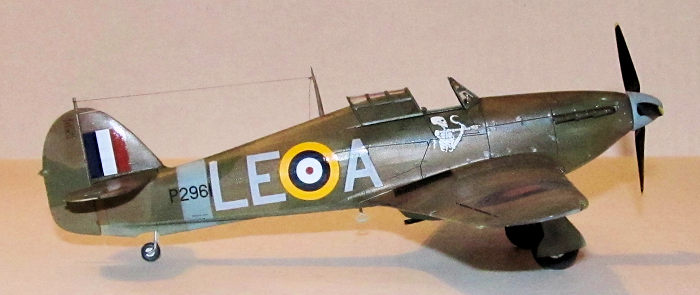 The Airfix Hurricane is a straight forward kit to
build. I started by painting all the parts for the interior of the wings, wheel
well and cockpit before removing them. I used Tamiya XF-71 for the British
Interior Green areas, Vallejo metal Color White Aluminum for the bare metal and
black for the instrument panel. The parts were cut off and glued together in the
order seen in the instructions. One item I did not use was the kit seat as I
replaced it with a painted and weathered with a wash Ultracast resin seat with
harnesses. There is an option to show off the wing guns on both wings but I
didn't do that.
The Airfix Hurricane is a straight forward kit to
build. I started by painting all the parts for the interior of the wings, wheel
well and cockpit before removing them. I used Tamiya XF-71 for the British
Interior Green areas, Vallejo metal Color White Aluminum for the bare metal and
black for the instrument panel. The parts were cut off and glued together in the
order seen in the instructions. One item I did not use was the kit seat as I
replaced it with a painted and weathered with a wash Ultracast resin seat with
harnesses. There is an option to show off the wing guns on both wings but I
didn't do that.
Constructing the rest of the plane was as simple as it was in real life. The fuselage and wings were glued together with CA glue on the visible seams and Tamiya Extra Thin cement on the hidden seams. Filling and sanding the various seams was not a big deal and only required a small amount of touch ups.
| COLORS & MARKINGS |
William McKnight's Hurricane was painted in the RAF
Dark Earth/Dark Green scheme A as per the decal sheet and masking set
instructions. The model was first primed with Stynylrez Primer. The landing gear
wells were masked off and sprayed silver along with the landing gear. Once the
cockpit and main wheel well
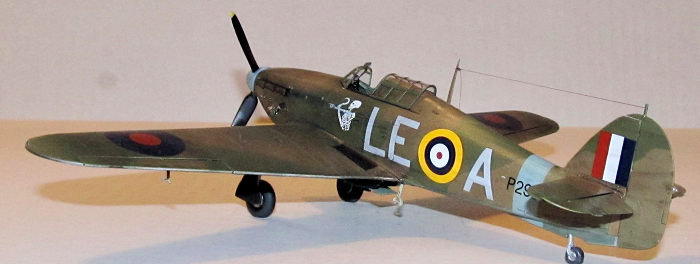 were masked off, I sprayed on the underside coat of Tamiya Sky which one half was masked off and then painted flat black. I sprayed
in random patterns to attempt to recreate a blotchy slightly worn paint job.
Once the sky was dry, I masked off the underside using low tack tape and dark
green areas with vinyl masks then sprayed on Gunze Dark Earth (again in a random
blotchy pattern.) When the Dark Earth was dry, I used the Vinyl masks for the
Dark Earth areas and sprayed on Tamiya Dark Green in the random blotchy pattern.
were masked off, I sprayed on the underside coat of Tamiya Sky which one half was masked off and then painted flat black. I sprayed
in random patterns to attempt to recreate a blotchy slightly worn paint job.
Once the sky was dry, I masked off the underside using low tack tape and dark
green areas with vinyl masks then sprayed on Gunze Dark Earth (again in a random
blotchy pattern.) When the Dark Earth was dry, I used the Vinyl masks for the
Dark Earth areas and sprayed on Tamiya Dark Green in the random blotchy pattern.
The canopy and windscreen pieces were masked off and painted first British Interior Green, Stynylrez primer and then dark earth/dark green (the primer was added to give the canopy paint the same background color tone .)
Lastly, the prop hub was painted Sky Blue (Tamiya XF-23) while the prop blades were done in flat black and chrome yellow at the tips.
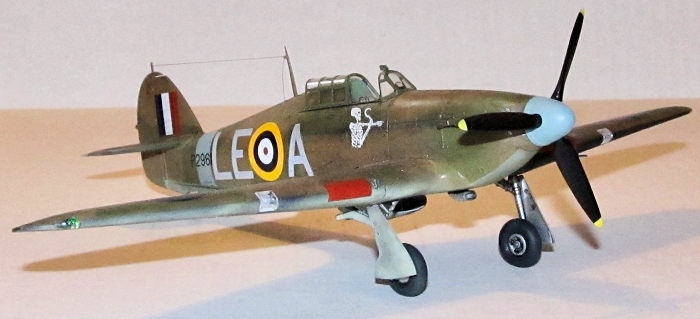 I used the Aeromaster Early War Hurricanes Decal
Sheet which had the William McKnight decals and is around 20 years old. Despite
the age, I had no issues with the Aeromaster decals. The stencils were a mix of
decals from the Airfix and Aeromaster sheets. I used some MicroSol underneath
the decal and MicroSet and/or Solvaset for the really stubborn ones. It took a
couple of days for the decals to settle down before I started to weather the
Hurricane.
I used the Aeromaster Early War Hurricanes Decal
Sheet which had the William McKnight decals and is around 20 years old. Despite
the age, I had no issues with the Aeromaster decals. The stencils were a mix of
decals from the Airfix and Aeromaster sheets. I used some MicroSol underneath
the decal and MicroSet and/or Solvaset for the really stubborn ones. It took a
couple of days for the decals to settle down before I started to weather the
Hurricane.
I used black and burnt umber oil washes for the
weathering as I wanted to practise this technique instead of my usual watercolor
wash which had been giving me fits lately. One thing I found out is that the
“odorless” turpenoid thinner gives me a bad headache so I had to use this in a
ventilated area (my workshop.) I used a flat wide brush dipped lightly with wash
and applied a thin coat all over the model. When the thinner evaporated, I used
Q-tips dipped in Turpenoid to wipe away enough of the oil paint to my
satisfaction (I w anted the Hurricane to look used but not neglected/South West
Pacific.) I used a thinner pointy brush for more prominent oil/gunfire/fuel
stains. I made the wheel wells rather dirty and the Airfix detail popped out
with the wash.
anted the Hurricane to look used but not neglected/South West
Pacific.) I used a thinner pointy brush for more prominent oil/gunfire/fuel
stains. I made the wheel wells rather dirty and the Airfix detail popped out
with the wash.
The oil wash was left for a week to dry before I sealed it up with two thin airbrushed coats of Tamiya Flat Clear.
The painted landing gear and doors were installed without too many issues. Airfix did a really good job of designing the landing gear to be easy to install unlike the Hasegawa version which if I recall correctly to be a bit fiddly.
Lastly the prepainted gunsight was added to the cockpit, the exhausts to the engine section then finally the antenna (with antenna wire made from Uni thread) and pitot tubes.
| CONCLUSIONS |
The Airfix Hurricane is definitely a step up on its nearest rival the Hasegawa Hurricane. Its easy to build design eliminates many of the headaches of the Hasegawa including the notorious step between the fabric covered areas on the underside of the fuselage.
I liked using the precut vinyl masks for the camo scheme because I dislike making masks and they don't turn out as well as precut ones.
Definitely recommended for all skill levels.
June 2020 Copyright ModelingMadness.com.
Review kit courtesy of my wallet If you would like your product reviewed fairly and fairly quickly, please contact the editor or see other details in the
Note to
Contributors. Back to the Main Page
Back to the Review
Index Page
Back to the Previews Index Page